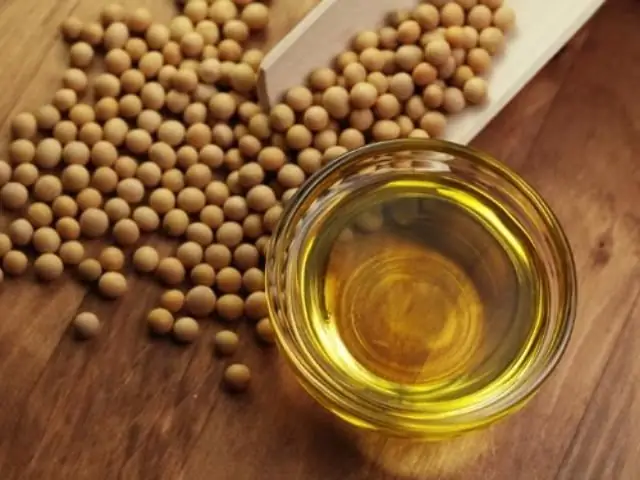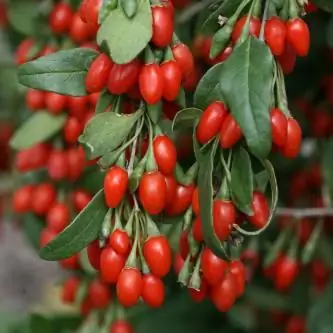2026 Author: Isabella Gilson | [email protected]. Last modified: 2025-01-23 12:50:34
How much delicious and incredibly useful Mother Nature gives us! In this article, we invite you to dive into the world of spices and talk about what anise is, what beneficial properties its fruits have and where they are used. We will talk about self-growing this plant at home and about the rules for harvesting anise seeds for future use.
What is anise?

Anise ordinary is an ancient medicinal plant that belongs to the umbrella family. Anise seeds have been found more than once in buildings dating back to the Stone Age. Common anise has names such as sweet cumin, vegetable anise, and anise thigh.
Description of anise

This plant is an annual, finely hairy. Its smooth rounded dense stems reach a height of 30 to 70 cm and branch at the top. A thin, spindle-like root grows into the ground to a depth of 30 cm.
Leaves closer to the roots, rounded, with large teeth, growon long petioles. The middle leaflets, located on the stem, are rounded and have palmate incisions. The upper leaves are tri- or five-pinnate and wedge-shaped. The flowers are very small, usually white, but sometimes with a slightly pinkish tint. Anise fruits are nothing more than an ovoid or pear-shaped forks with a slight ribbing. In simple terms, these are anise seeds. Their color is gray-green or gray-brown. Anise fruits are characterized by a strong spicy aroma and sweetish taste. Anise is also a honey plant. The rich flowering of umbrellas is a favorable environment for bees, which produce incredibly fragrant anise honey.
Homeland and distribution of anise

To date, it has not been possible to find reliable information about where anise was first discovered and began to be cultivated. According to some sources, its homeland is Asia Minor, other sources say that anise came to us from Egypt. Currently, anise can be found on almost any continent, in any country, be it Russia, Spain, France, Japan, America, India, the Netherlands, Mexico, Afghanistan or Turkey. In our country, anise is actively and successfully cultivated in the Voronezh and Kursk regions, in the Krasnodar Territory.
Healing properties of anise

The main purpose of anise seeds is medicinal. The beneficial properties of anise seeds were already known to Pythagoras and Hippocrates, who actively used them as a medicine. Due to the high content of essential oils infruits, the main use of anise is in the treatment of coughs and other diseases of the upper respiratory tract.
Anise as an antispasmodic is often included in gastric and laxative preparations. It has a calming and analgesic effect, so it is often prescribed for intestinal colic and bloating. Thanks to its carminative properties, it quickly relieves spasm in the intestines and improves the secretory function of the digestive tract.
Anise fruit decoction is often prescribed for breastfeeding mothers as it stimulates milk production and improves uterine contractions, which is very important after childbirth.
The smell of anise essential oil is not tolerated by many insects: lice, cockroaches and ticks. Below we will share with you the most popular and effective traditional medicine recipes.
- To increase the amount of milk produced during lactation, you need to eat 2 tablespoons of anise seeds 3-4 times a day. You can combine them with honey and drink warm tea.
- With constant bloating and intestinal colic, anise is used in combination with other herbs. Prepare a decoction of equal parts anise seeds, chamomile flowers, mint leaves, and cumin. A day you need to drink at least a glass of this decoction.
- If there are no other herbs at hand, you can make anise tea for intestinal colic. To do this, a teaspoon of well-ground anise seeds is poured into a glass of boiling water and allowed to brew for an hour. You need to use this tea 3 times a day, 1 tablespoon. At a higher dosage, tea can significantly increase appetite.
- With gastritis and sharppain in the stomach stronger and infused anise tea drink a quarter cup, at least 4 times a day.
- With amenorrhea or, on the contrary, too heavy menstruation, a piece of sugar moistened with 3-4 drops of anise oil, consumed 3 times a day, helps. Anise oil helps to normalize the menstrual cycle.
- Infusion of anise seeds in milk with honey helps well against insomnia. Just a teaspoon of anise fruit, a glass of milk and a spoonful of honey is enough - and in 15 minutes you will be sleeping like a baby.
- Anise infusion can help in skin rejuvenation. To do this, you need not only to take it inside, but also wipe your face with it daily.
- Anise oil combined with sunflower will help get rid of lice. Just rub the oil well into your head, wrap it in a bag and a towel, and start combing out after a few hours. Repeat the procedure every three days until the lice disappear completely.
- In case of inflammation of the lungs, it is necessary to use an infusion of anise and linden. To do this, the seed and leaves are mixed in equal proportions and poured with boiling water. After half an hour of infusion, the decoction can be drunk.
- Protracted bronchitis can be cured with the help of this mixture: 100 g of flaxseeds, 20 g of anise fruits, 30 g of ginger and 0.5 kg of garlic-honey mass with lemon must be thoroughly mixed and consumed in a teaspoon several times a day. day.

If you do not have time to prepare infusions and decoctions, you can buy ready-made anise drops at the pharmacy. It is about them that will be discussed in the followingsection.
Anise Drops
Anise oil thins and removes phlegm from the bronchi, relieves inflammation and reduces sore throat. In pharmacy chains, you can find a combined drug - anise drops with ammonia. Ammonia in combination with anise oil disinfects, promotes rapid regeneration of mucous membranes and quickly thins sputum, which speeds up the process of cough treatment. A particular advantage of these drops is their use at any age. Thanks to their completely natural composition, they can treat coughs even in young children. The rather low cost (about 70 rubles) makes them affordable for all segments of the population.

The use of anise in cooking
Not only anise seeds, but also anise oil are widely used in bakery and confectionery production, in the preparation of meat, fish dishes and even drinks. Anise fruits have a refreshing aroma that, as a gourmet spice, will perfectly decorate almost any dish, be it soup or dessert.

Growing anise in my garden
Growing anise on your own plot is not a troublesome and rather pleasant task. Anis, oddly enough, loves both cold and warm. Almost any land is suitable for planting it, except for clay. It will grow especially well in the ground after potatoes and legumes. A month before frost, carefully dig up the area for planting anise to a depth of at least 30 cm. As soon as all the snow comes off in the spring and the soil dries well, it must bedig, but not so deep - by 5-6 cm. For sowing, fruits no older than two years of age are used, since older seeds may simply not sprout. Before planting, you need to let them germinate a little. To do this, simply hold the seeds in a wet cloth for about a week. Do not forget to moisten the drying rag. As soon as you notice that small sprouts have appeared, remove excess moisture by drying them slightly.
Sprouted seeds are planted at a depth of 4 cm and with a distance between rows of 30 to 50 cm. For anise to grow powerfully and bring a good harvest, be sure to loosen the soil, destroy weeds and fertilize the land.
Preparing anise for the winter
Anise is harvested only after it is fully ripe - in August or September. Ripe anise fruits fall off easily, so the process of collecting seeds will not cause unnecessary difficulties. The collected seeds must be dried in a dry and dark place for at least five days or in an oven at a low temperature. It is very easy to determine whether the seeds have dried out enough - they will decrease in volume by half. Then they need to be thoroughly threshed, remove impurities and all the husks. Dried seeds are stored in a tin in a dry, dark place.
Contraindications to the use of anise fruits
The main contraindication to use is the presence of an allergic reaction to the fruits and the essential oils contained in them. Another disease that does not tolerate essential oils is a stomach and duodenal ulcer. Women should use anise with caution during pregnancy. Do not abuse anise if you haveyou have increased blood clotting.
Recommended:
The benefits and harms of soybean oil. Properties and uses of soybean oil

The use of soybean oil occupies a leading position in global production. It has become a champion among other oils due to its valuable chemical composition and wide application possibilities both in the food industry and in cosmetology and pharmaceuticals. Some are afraid of this product, linking the harm of soy oil to the body with a myth that has enveloped all existing products, one way or another related to the word "soy". In this article, we will try to dispel this unfounded misconception
Kombu algae: description, photos, useful properties, uses and recipes

The menu of the inhabitants of the Land of the Rising Sun is 80% seafood. And this is not only waterfowl, but also plants. There are 30 species of algae alone that are eaten in Japan. Among them, kombu stands out. What is seaweed and how to cook it? About this and not only in the article
List of fruits. Sweet fruits. Russian fruits

In our time, when the delivery, processing and storage of perishable products has ceased to be a problem, and breeders are constantly offering new varieties of fruit plants, the list of fruits that most often appear on our tables has changed significantly
Anise tincture: recipe, composition, useful properties and contraindications

Anise tincture appeared one of the very first existing alcoholic beverages. The classic recipe for making anise has been handed down since ancient times. It is simply impossible to confuse this drink with any other, despite the fact that different methods are used to create alcohol and different spices are used
Harm and benefits of linseed oil for women. Flaxseed oil: properties, uses and treatment

Flaxseed oil is a colorless or yellowish oily liquid obtained from ripe and dried flaxseeds. It is in demand for eating, because it has a high level of Omega-3 fatty acids and many other substances necessary for a person

